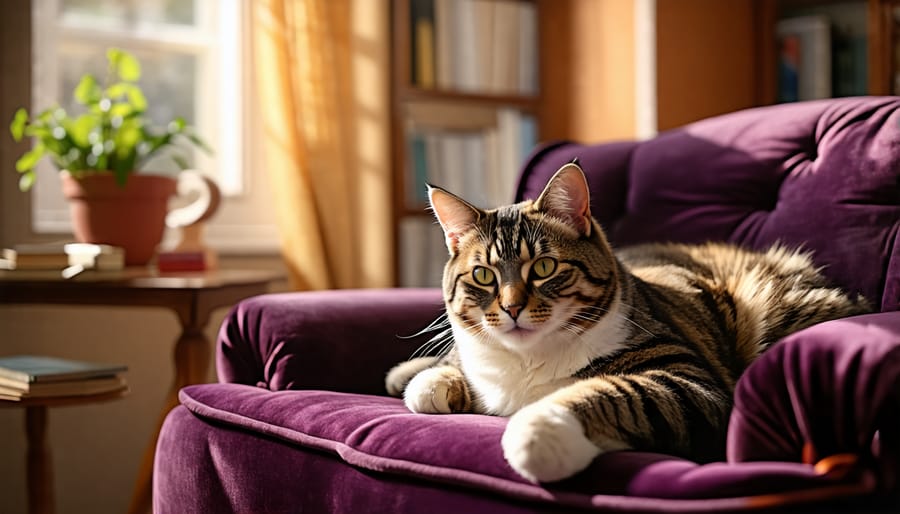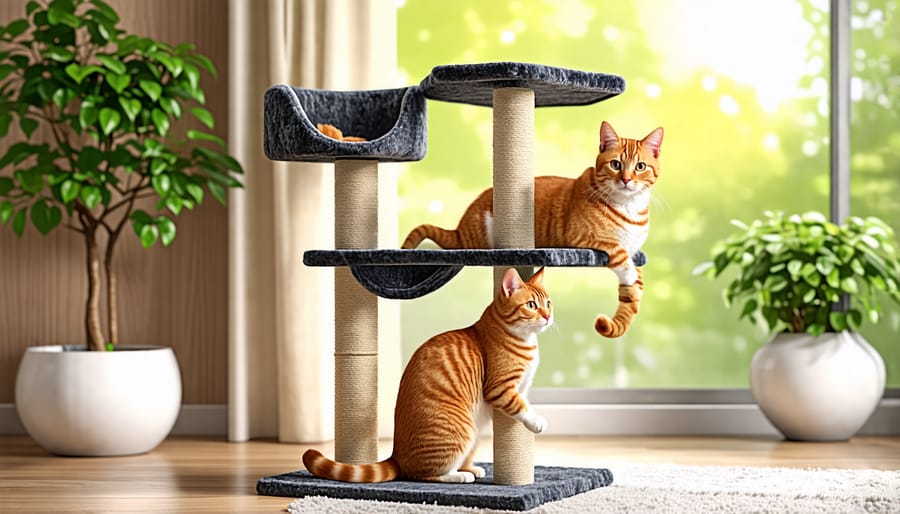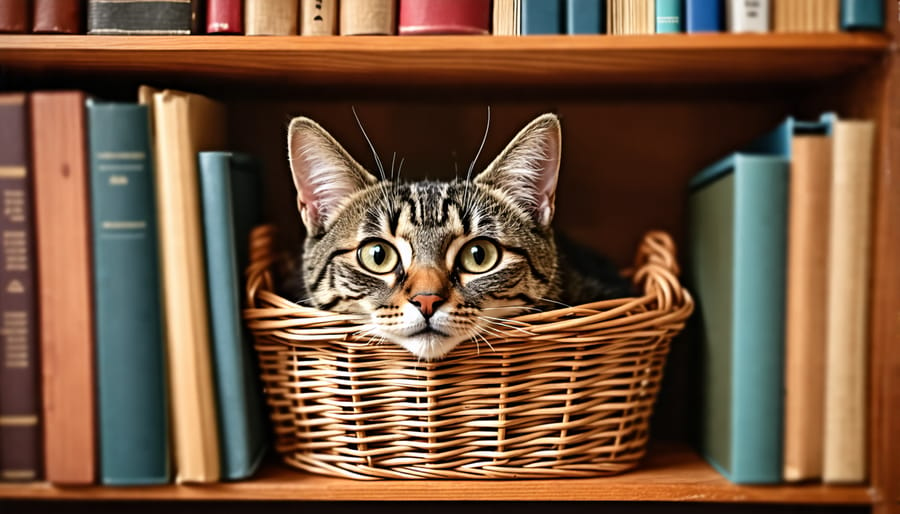Create a cat-centric layout with accessible perches, cozy nooks, and vertical space for climbing and exploration. Choose durable, easy-to-clean fabrics like microfiber or canvas for upholstery and avoid delicate materials prone to snagging or staining. Incorporate cat-specific features such as built-in feeding stations, litter box enclosures, and scratching posts that double as stylish decor elements. Prioritize your cat’s safety by securing fragile items, covering electrical cords, and ensuring window screens are sturdy to prevent escapes or accidents.
Choose the Right Fabrics
Best Fabric Options
When selecting fabrics for your cat-friendly home, prioritize materials that are durable, easy to clean, and resistant to scratching. Microfiber is an excellent choice, as it’s soft, stain-resistant, and can withstand daily wear and tear. Leather is another great option, as it’s easy to wipe clean and less likely to attract pet hair. However, keep in mind that some cats may still scratch leather surfaces.
Canvas and denim are also sturdy options that can hold up well against cat claws. For a more luxurious feel, consider velvet, which is both soft and durable. Avoid delicate fabrics like silk or linen, which can easily snag or tear.
When it comes to upholstery, opt for tight-weave fabrics that won’t catch your cat’s claws. Crypton fabrics are specially designed to be stain-, moisture-, and odor-resistant, making them ideal for homes with pets. For bedding and throw pillows, choose washable fabrics like cotton or polyester blends that can be easily laundered to remove fur and odors.
By selecting the right fabrics for your home, you can create a stylish and inviting space that both you and your feline friend will love.

Fabrics to Avoid
When selecting fabrics for your cat-friendly home, it’s best to steer clear of delicate materials like silk, velvet, and linen. These fabrics can easily snag or tear under your cat’s claws, leading to unsightly damage. Additionally, avoid hard-to-clean fabrics such as suede or heavily textured upholstery, as they can trap cat hair and odors. Opt for durable, easy-to-clean materials like microfiber, canvas, or leather instead. These fabrics are more resistant to scratches and can be wiped down or vacuumed regularly to keep your home looking fresh and tidy. When in doubt, choose fabrics that prioritize both style and practicality to create a space that you and your feline friend can enjoy together.
Create High Perches
Cats love to climb and perch up high, so incorporating vertical space into your interior design is a must for creating a feline-friendly home. Cat trees are a popular option, offering multiple levels for climbing, scratching, and lounging. Look for sturdy models that complement your decor, such as those with natural wood or sleek, modern finishes. Wall-mounted shelves are another great way to give your cat a lofty vantage point. Install them at varying heights, ensuring they’re securely anchored and wide enough for your cat to comfortably rest. For a DIY approach, consider repurposing floating bookshelves or creating your own perches using wooden crates or baskets attached to the wall.
Window perches are a favorite among cats, allowing them to soak up the sun and watch the world go by. You can purchase ready-made window perches that attach to your sill, or craft your own using a cushioned board or a cozy bed secured to the windowsill. If you have a larger window, consider installing a cat hammock or a series of shelves to create a kitty climbing wall. By providing your cat with plenty of vertical space to explore, you’ll keep them entertained, active, and content while adding a unique design element to your home.

Provide Cozy Nooks
Cats love to curl up in cozy, secluded spots for naps and relaxation. To create inviting, semi-enclosed spaces for your feline friend, consider the strategic arrangement of furniture and accessories. Position a side table next to a sofa or armchair, leaving just enough space for your cat to squeeze in and feel protected on three sides. Drape a soft blanket over the gap to enhance the sense of seclusion.
Another option is to place a cat bed or cushion inside a bookshelf nook, surrounded by their favorite toys and a small scratching post. This creates a miniature cat haven within your living space. You can also invest in or build a window perch, providing a lofty spot for your cat to survey their domain while basking in natural light.
Wicker baskets, fabric tunnels, and even cardboard boxes can be transformed into irresistible cat nooks with the addition of a plush liner or blanket. Scatter these DIY retreats throughout your home, giving your cat plenty of options for solo downtime. Remember, the key is to offer semi-enclosed, softly padded spaces that cater to your cat’s instinctive desire for comfort and security.

Incorporate Scratching Surfaces
Incorporating scratching surfaces throughout your home is essential for creating a cat-friendly environment while protecting your furniture. Instead of settling for unsightly scratching posts, opt for attractive options that blend seamlessly with your decor. Look for stylish scratching posts covered in natural materials like sisal rope or woven fabric, which come in sleek designs that complement modern interiors. Wall-mounted scratching pads are another space-saving solution, offering your cat a designated scratching area without taking up floor space. Consider placing these near your cat’s favorite lounging spots or in high-traffic areas to encourage use. For a more integrated approach, try incorporating a cat tree or condo that combines scratching surfaces, perches, and hideaways into a single, attractive piece of cat furniture. With a variety of colors, materials, and designs available, you can easily find options that suit your aesthetic preferences while providing your feline friend with ample scratching opportunities. Remember to praise and reward your cat for using the designated scratching areas, reinforcing positive behaviors that will help protect your belongings in the long run.
Keep Litter Boxes Discreet
Integrating your cat’s litter box into your home’s decor can be a challenge, but with a little creativity, you can keep it discreet and stylish. One option is to repurpose a piece of furniture, such as a side table or cabinet, to house the litter box. Look for a design with a door or curtain to conceal the box when not in use. You can also consider building a custom enclosure that matches your room’s aesthetic, such as a sleek wooden box with a cut-out entrance for your cat.
If you prefer a ready-made solution, there are many attractive litter box furniture options available, from modern designs to rustic styles. These pieces often feature built-in odor control and easy-to-clean surfaces, making maintenance a breeze. For a more budget-friendly approach, try using a decorative screen or room divider to separate the litter box area from the rest of the room. This creates a designated space for your cat while keeping the box out of sight.
When choosing a location for the litter box, consider both your cat’s preferences and the room’s layout. A quiet corner or alcove can provide privacy for your pet while minimizing visibility. Just be sure to keep the box easily accessible and away from high-traffic areas or noisy appliances that may deter your cat from using it. With these clever solutions, you can maintain a clean, comfortable space for your feline friend without compromising your home’s style.
Use Pet-Safe Plants
When selecting houseplants, opt for pet-safe plants that won’t harm your feline friend if ingested. Some popular non-toxic options include spider plants, African violets, bamboo palm, friendship plants, and Boston ferns. These lush greens not only elevate your home’s aesthetic but also provide a safe environment for your cat to explore. Other cat-friendly choices include certain succulents like echeveria and haworthia, as well as herbs such as thyme and basil. When in doubt, consult the ASPCA’s comprehensive list of toxic and non-toxic plants to ensure your greenery is feline-approved. By incorporating these pet-safe plants into your interior design, you can create a stylish and inviting space that both you and your cat will love.
Secure Breakables
When displaying delicate decor pieces in a home with cats, it’s essential to keep them out of paw’s reach. One solution is to use wall-mounted shelves or display cases with doors, ensuring your treasured items are both secure and showcased. For added protection, consider using museum putty or adhesive strips to keep objects stable on surfaces. Another option is to repurpose a glass-front cabinet or bookcase as a display space, providing a barrier between curious cats and fragile items. When styling shelves, place sturdier pieces on lower levels and more delicate ones higher up. Alternatively, opt for decor that is less likely to break, such as metal sculptures, wood carvings, or canvas wall art. By thoughtfully curating and arranging your decor, you can maintain an elegant, cat-friendly home without compromising on style or your feline friend’s safety.
Conclusion
Creating a cat-friendly home doesn’t mean sacrificing style or comfort. By selecting durable, easy-to-clean fabrics, providing plenty of scratching posts and perches, and incorporating hidden litter box solutions, you can design a space that both you and your feline friend will love. Remember to prioritize your cat’s safety by keeping dangerous items out of reach and securing loose wires. With a few smart design choices, you can create a harmonious living environment that caters to your cat’s natural instincts while maintaining a cozy home aesthetic. Embrace your creativity and have fun designing a space that both you and your feline companion will enjoy for years to come.
